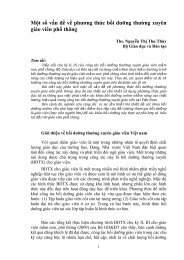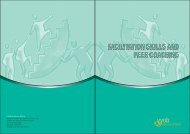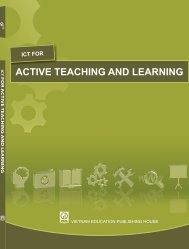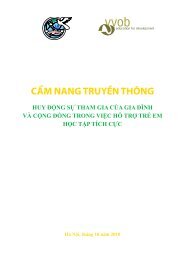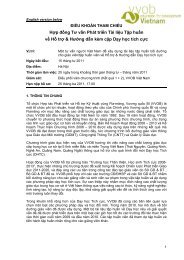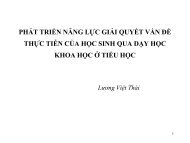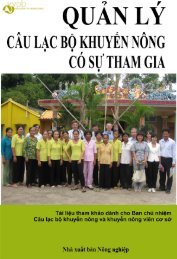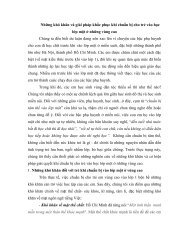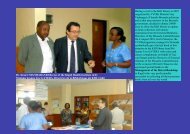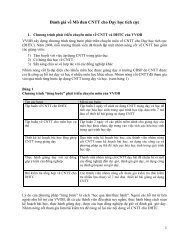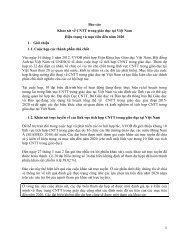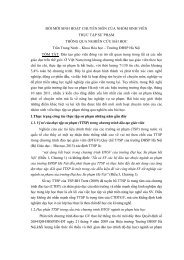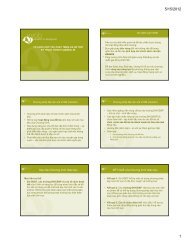Kenya Multi-Year Programme 2011-2013 - VVOB
Kenya Multi-Year Programme 2011-2013 - VVOB
Kenya Multi-Year Programme 2011-2013 - VVOB
- No tags were found...
Create successful ePaper yourself
Turn your PDF publications into a flip-book with our unique Google optimized e-Paper software.
5. General framework of the cooperation strategy <strong>2011</strong>-<strong>2013</strong>5.1. Principles of a continued cooperation5.1.1. Inclusion in the national education policy and the strategic framework “Education andtraining for Vision 2030”The proprosed programme is fully aligned with the plans of the <strong>Kenya</strong> Government to accelerateprogress ―towards a globally competitive system of quality education, training and research forsustainable development‖, through KESSP (See also 3.2.2).The programme 2010- <strong>2013</strong> is also linked to other national policies and strategies such as:The e-Government Strategy; the National ICT Strategy; the School Health Policy; the NationalStrategy for Health & Nutrition; the Education & Gender Policy, the (draft) Strategy for Education forSustainable Development.5.1.2. Geografical choiceThe geographical focus for the interventions of the new programme will not change from the previousphase (2008-2010).Most activities will be in Nairobi, where the national operational partners are based. For sustainability,the focus will be on collaboration with and strengthening of the capacity of the higher and middle levelcadres of the MOE Headquarters and staff of the in-service training centre for mathematics andsciences.There will be further development of the capacity of a number of district education officers and schoolmanagement teams in about 9 or 10 districts, outside the capital. Collaboration with 30 HealthyLearning schools in those less developed districts will continue.However, with sustainability in mind, the programme will look for opportunities to actively engage withother KESSP Investment <strong>Programme</strong>s (eg school infrastructure, primary in-service training, qualityassurance) for wider adoption of the programme‘s lessons learned, approaches, developed policiesand guidelines. These investment programmes have a wide geographical spread.5.1.3. Thematic choiceThe proposed multi-year programme <strong>Kenya</strong> <strong>2011</strong>- <strong>2013</strong> is based on the following principles:Integrated in sector planning (<strong>Kenya</strong> Education Sector Support <strong>Programme</strong>- KESSP) and the linkeddonor coordination.Responding to requests from the current main strategic partner, the Ministry of Education, asformulated in the Collaborative <strong>Programme</strong> 2008-<strong>2013</strong>Explicit adoption of a programme approach.Limited to one sector (education).Build on experiences and achievements of phase I (2008 – 2010) of the MOE-<strong>VVOB</strong> Collaborative<strong>Programme</strong>.The thematic choice is a combination of several focal points:The first focus is strengthening the capacity of the Ministry for coordination, communication,planning and implementation, quality assurance, change management. The programme will engagemanagers at national and district level.The second focus is strengthening of school management teams (heads of school, members ofschool committees) as an important change factor. UNESCO research has shown that schoolshave to be part of, and have ownership of every attempt for education reform. Real improvementsrequire group dynamics and empowerment of teachers and capacity development. It has also beenproven that ―bottom-up-processes‖ of education planning and curriculum development are the most<strong>Kenya</strong> - <strong>Multi</strong>-<strong>Year</strong> <strong>Programme</strong> <strong>2011</strong>-<strong>2013</strong> 26/148



